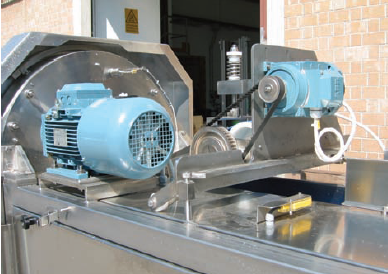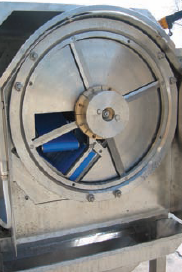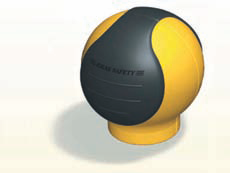The Italian manufacturer of equipment for processing fruit and vegetables, Tecnoceam, has solved problems related to the cleaning of its machines by using safety sensors. Furthermore they reduced the wiring costs, time for mounting and eliminate mechanical alignment problems.
Tecnoceam in Sala Baganza (PR) Italy, has been designing and manufacturing machines and equipment for the food industry for almost 30 years. Thereby, they create advanced product lines using high quality material and components, offering technical solutions for the processing and preservation of fresh, grilled or pickled vegetables and sauces or vegetables in oil. The company, located in the province of Parma, produces various machine types and their experience is recognised world-wide in this market sector.
The task which arose at Tecnoceam’s was to protect the slice-cutting machine in an appropriate way. In fact, this machine has on its front a system of rotating knives, which is very dangerous for the operator during processing.Therefore, it must meet the highest safety category 4 according to EN 954-1. Another problem was to equip the doors and hatches with a safety device which reliably withstands the frequent cleaning to which this type of machine and generally all machines used in the food sector are exposed.
Both requirements are achieved using theEden E non-contact safety sensor. Thanks to its transponder technology, it is possible to mount the sensor, consisting of the active part Adam and the passive part Eva, at a distance of up to 12mm. Both parts can be arranged opposite to one another, in parallel,at a right angle or at any other angle.
This solution corresponds to the safety category4 and allows connection of several sensors in series to the same input of the safety control, without losing the highest safety level. When using traditional technologies, as erial connection leads to a downgrading to safety category 3. The rugged construction of the non-contact sensor meets the protection class IP69K and enables an operating temperature range from -70 to 100°C. These features have resulted in the solution Tecnoceam had been looking for a long time, as conventional mechanical switches are notable to meet the high demands of the toug henvironment these machines are required to operate in.
Another particularity of the technology used is that it is possible to mount one single transmitter/receiver pair on a double wing door, thus reaching the safety category 4. In order to obtain the same result with conventional switches, it was necessary t obuild-in two separate devices, one for each door. This greatly increased the wiring costs and the time for mounting, also because of the difficult alignment of the door and the end stop of the conventional switches. Part of the safety circuit required a relatively costly delayed control and supervision of the different possibilities of access to the danger zone, due to the stopping time of the cutting knives system with a high inertia of masses.
In order to meet this demand, the company chose the safety PLC Pluto which utilises programmable time function elements, thus offering an easy implementation and maximum flexibility. Pluto represents the state of the art in safety PLC technology and offers an extremely compact, versatile and easily programmable solution. The associated intuitive Pluto Manager software is made available to the user free of charge. Up to 32 Pluto’s can be connected to the safety bus thus allowing for complex networks.
Pluto’s capability to download the software from the neighbouring PLC’s makes it also possible to solve the problem of maintenance personnel replacing units without the need of a PC or laptop. Each Pluto connected to the bus has its own programme and has stored those of all the other PLC’s. If another unit should fail, it can be replaced with a new, unprogrammed one, pressing one key on its front informs the others that it is ready for the data transmission. The transmission takes only a few seconds, and the new PLC continues to work as if nothing had happened. In this case, thanks to the detachable connector blocks, it is not necessary to disconnect the different wires, and one needs not use a PC, software or programme in order to restore the operation of the machine without any complications that can arise incertain situations.





















